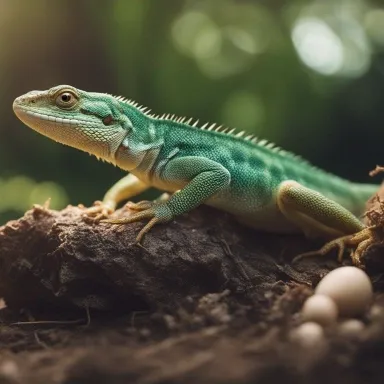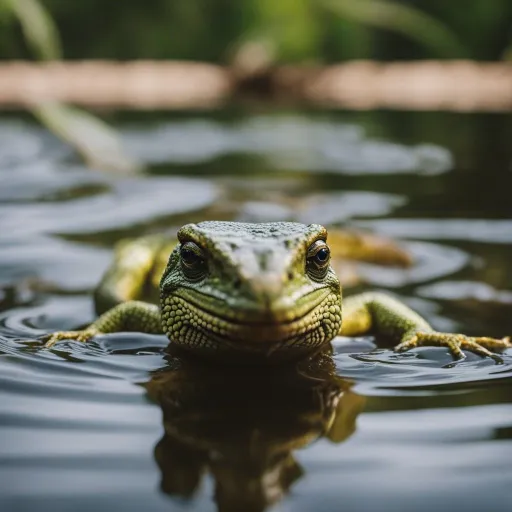So you’re curious about where lizards lay their eggs, huh? Well, you’ve come to the right place! In this article, we will uncover the mysterious world of lizard egg-laying habits.
If you’ve ever wondered why lizards seem to disappear when it’s time to lay eggs or if they have any specific preferences for their nests, then prepare to have your reptilian curiosity satisfied.
Get ready to learn all about the fascinating reproductive behaviors of our scaly friends and unravel the secrets of their egg-laying rituals. It’s time to embark on a journey into the wild world of lizards and their eggs!

Understanding the Egg-Laying Habits of Lizards
Lizards are fascinating creatures, with diverse behaviors and reproductive strategies. One of the most intriguing aspects of lizard reproduction is their egg-laying habits.
In this article, we will explore the different facets of lizard egg-laying, including their reproductive anatomy, factors influencing egg-laying behavior, nest selection and preparation, the process of egg development and laying, egg characteristics and adaptations, parental care, and the challenges and risks associated with egg survival.
By understanding these aspects, we can gain valuable insights into the remarkable world of lizard reproduction.
Introduction
Overview of lizard egg-laying
Lizards belong to the reptile group, and lay eggs as part of their reproductive strategy. Unlike mammals, which give birth to live young, lizards rely on laying eggs to reproduce.
This behavior is common among various lizard families, including geckos, iguanas, skinks, and many others.
By understanding the nuances of their egg-laying habits, we can better appreciate the diversity and complexity of lizard reproductive strategies.
Why studying lizard egg-laying is important
Studying lizard egg-laying behaviors is crucial for several reasons. Firstly, it provides us with insights into the evolution and adaptation of reptilian reproductive strategies.
By understanding the factors that influence egg-laying, such as environmental cues and hormonal influences, we can gain a better understanding of how lizards have adapted and survived in various habitats over millions of years.
Secondly, the knowledge gained from studying lizard egg-laying can be applied to conservation efforts.
Understanding the specific needs and requirements of lizards during egg-laying can help us protect and manage their habitats to ensure successful reproduction and population viability.
Lastly, the study of lizard egg-laying can also provide valuable information about reproductive physiology in general, as reptiles share certain similarities with other vertebrates.
Types of lizards that lay eggs
While many lizard species are oviparous, or egg-laying, it is important to note that not all lizards follow this reproductive strategy.
Some lizard species, known as viviparous lizards, give birth to live young. These species retain the eggs within their body until they hatch, providing nourishment to the developing embryos through a placenta-like structure.
Examples of viviparous lizards include certain species of skinks and geckos. However, in this article, we will primarily focus on the egg-laying habits of lizards, which constitute the majority of reptile species.
Reproductive Anatomy of Lizards
General reproductive anatomy of lizards
To understand lizard egg-laying, it is important to have a basic understanding of their reproductive anatomy. Lizards possess reproductive organs that enable them to produce and lay eggs. Both male and female lizards have a pair of gonads, known as testes in males and ovaries in females, which produce sperm and eggs, respectively. During mating, a male lizard transfers sperm to the female’s body, where it fertilizes the eggs. In some lizard species, males may possess specialized structures, such as hemipenes, to facilitate sperm transfer.
Differences in reproductive anatomy between egg-laying and live-bearing lizards
The reproductive anatomy of lizard species that lay eggs differs from those that give birth to live young. One key difference lies in the presence of specialized structures in viviparous lizards that aid in embryonic development and nourishment. These structures include a placenta-like organ and an oviduct that provides a nurturing environment for the developing embryos. In contrast, egg-laying lizards lack these structures and rely on external factors, such as temperature and humidity, to support the development of their eggs.
Adaptations for egg-laying
Egg-laying lizards have evolved a range of adaptations to ensure successful reproduction. One notable adaptation is the production of larger clutches of eggs compared to viviparous lizards. This is because egg-laying lizards do not have the benefit of internal nurturing structures to support individual embryos. Additionally, these lizards display various behaviors and physiological mechanisms to select suitable nest sites, regulate incubation temperature, and protect their eggs from predators. These adaptations contribute to the survival and successful hatching of their offspring.
Factors Influencing Egg-Laying Behavior
Environmental factors
Numerous environmental factors influence the egg-laying behavior of lizards. Temperature, humidity, and the availability of resources are key considerations for lizards when selecting nest sites. Lizards often choose nesting areas that provide optimal conditions for egg development and incubation, such as areas with stable temperatures and suitable substrate for digging and concealing the nest.
Seasonal variations and hormonal influences
Lizards often exhibit seasonal patterns of reproduction, with specific times of the year favored for egg-laying. Environmental cues, such as changes in day length and temperature, trigger hormonal changes in lizards, signaling the onset of the breeding season. These hormonal influences play a crucial role in regulating egg production and the timing of egg-laying.
Availability of suitable nest sites
The availability of suitable nest sites is essential for the successful reproduction of egg-laying lizards. Lizards may select nest sites that provide protection from predators, stable temperature and humidity conditions, and ample resources for the growth and development of their offspring. The competition for suitable nest sites can be intense, leading to territorial behavior and conflicts among lizards.
Social interactions and territorial behavior
Social interactions and territorial behavior also play a role in egg-laying behavior. Lizards may establish and defend territories that contain preferred nesting areas. These territories not only provide access to resources but also reduce the risk of egg predation and interference from other lizards. Social interactions between males and females can influence mating opportunities and the likelihood of successful egg-laying.
Nest Selection and Preparation
Nesting site preferences
Lizards exhibit distinct preferences when it comes to selecting nesting sites. Some species prefer open areas with ample sunlight, while others seek out shaded areas or burrows for nesting. The selection of a suitable nesting site is crucial as it provides the necessary conditions for egg development and incubation.
Importance of substrate and temperature
The choice of substrate, or the material used for nest construction, is particularly important for lizard egg-laying. Many lizards excavate nests in soil or sand, while others may lay their eggs in leaf litter or crevices. The substrate not only provides physical support and protection for the eggs but also plays a role in regulating incubation temperature. Temperature is a critical factor for egg development, with slight variations influencing the sex determination and viability of the developing embryos.
Nest excavation and construction
Lizards exhibit various behaviors when it comes to nest excavation and construction. Some species dig elaborate tunnels or burrows to create a secure nest chamber, while others simply scrape out a shallow depression in the substrate. The process of nest excavation and construction can vary depending on the characteristics of the nesting site and the species of lizard involved.
Nest guarding
Once the eggs are laid, some lizard species exhibit nest-guarding behaviors. This involves the females actively protecting and defending the nest from potential predators or disturbances. Nest guarding can be crucial for the survival of the eggs, as it reduces the risk of predation and ensures a stable incubation environment.
Egg Development and Laying Process
Fertilization and egg formation
After mating, the female lizard’s body undergoes internal fertilization, where the male’s sperm fertilizes the eggs within the female’s body. Once fertilization occurs, the eggs begin to develop within the female’s ovaries. The process of egg formation involves the growth and maturation of the eggs, as well as the formation of eggshells.
Egg development and embryonic growth
As the eggs develop within the female’s body, the embryos go through various stages of growth. The length of the incubation period can vary depending on the species of lizard, with some eggs hatching within a few weeks, while others may take several months. During the incubation period, the developing embryos receive nourishment from the yolk sac, which provides essential nutrients for their growth and development.
Incubation temperature and its impact on sex determination
Incubation temperature plays a crucial role in the development of lizard embryos. In egg-laying species, temperature fluctuations during the incubation period can result in the determination of the offspring’s sex. For example, in some lizard species, higher temperatures during incubation may result in the development of male offspring, while lower temperatures may result in female offspring. This temperature-dependent sex determination is a fascinating characteristic of lizard reproduction.
Timing and frequency of egg-laying
The timing and frequency of egg-laying can vary among lizard species. Some lizards lay multiple clutches of eggs throughout the breeding season, while others may only lay a single clutch. The interval between clutches and the overall duration of the breeding season can be influenced by various factors, including environmental conditions and the reproductive physiology of the species.
Egg Characteristics and Adaptations
Egg size, shape, and coloration
Lizard eggs exhibit a wide range of sizes, shapes, and colorations. These characteristics may vary depending on the species of lizard and the specific adaptations they have evolved. Larger eggs are typically associated with egg-laying species, as they need to rely on external conditions for embryonic development. The shape and coloration of the eggs also contribute to efficient incubation and camouflage, providing protection against predators.
Eggshell composition and structure
The structure and composition of lizard eggshells are essential for protecting the developing embryos. Lizard eggshells are typically composed of calcium carbonate, giving them a hard and protective outer layer. The structure of the eggshell allows for gas exchange, allowing the oxygen necessary for embryonic development to enter while preventing excessive water loss.
Adaptations for protection and camouflage
Lizard eggs have evolved various adaptations to increase their chances of survival. Some species lay their eggs in concealed or inaccessible locations, reducing the risk of predation. Others, such as certain geckos, have eggs with bumpy or textured surfaces that provide better adhesion to their nest sites. Camouflage is another common adaptation, with eggs often matching the coloration and patterns of their surrounding environment, making them less visible to potential predators.
Parental Care and Nest Attendance
Maternal care in egg-laying lizards
While many lizard species do not provide parental care beyond egg-laying and nest guarding, some exhibit maternal care behaviors. Maternal care may involve post-oviposition behaviors, such as nest site selection and preparation, as well as the observation and protection of the eggs. Some species even exhibit behaviors like egg-rolling or adjusting the nest temperature to ensure optimal conditions for egg development.
Paternal care and shared parental responsibilities
Although less common than maternal care, some egg-laying lizard species also exhibit paternal care. This may involve the male lizard taking an active role in egg-guarding or contributing to nest excavation and preparation. In species with shared parental responsibilities, both the male and female lizards may take turns guarding the nest or sharing incubation duties.
Nest attendance and guarding
Nest attendance and guarding behaviors are crucial for the survival of lizard eggs. This involves the parents remaining near the nest, actively monitoring and protecting the eggs from potential predators or environmental threats. Nest attendance can entail adjustments in the positioning of the eggs, maintaining a suitable nest temperature, and defending the nest against intruders.
Egg Survival and Predation Risks
Natural predation threats to lizard eggs
Lizard eggs are vulnerable to various natural predators. Snakes, birds, mammals, and even other lizards can pose a threat to the survival of lizard eggs. These predators may locate and raid nests, consuming the eggs or feeding on the hatchlings. The risk of predation is particularly high for eggs laid in open areas or nests that are not well-concealed or guarded.
Physiological defenses against predation
Lizard eggs have evolved certain physiological defenses against predation. Some species produce eggs with a tough and thick shell, making it more difficult for predators to break through. Other species may deposit chemical substances on their eggs that act as deterrents or repellents for potential predators.
Factors influencing egg survival rates
Numerous factors influence the survival rates of lizard eggs. The quality of the nest site, the effectiveness of parental care behaviors, the presence of predators, and environmental conditions all play a role in determining the fate of the eggs. The interplay between these factors ultimately determines the likelihood of successful hatching and the survival of the hatchlings.
Final Thoughts
Understanding the egg-laying habits of lizards provides us with valuable insights into their reproductive strategies and the challenges they face.
From the intricacies of their reproductive anatomy to the factors influencing egg-laying behavior, and the adaptations and risks associated with nesting and egg survival, lizard egg-laying is a complex and fascinating phenomenon.
By studying and appreciating these aspects, we can gain a greater understanding of the natural world and work towards better conservation efforts to protect these remarkable creatures and their habitats.



